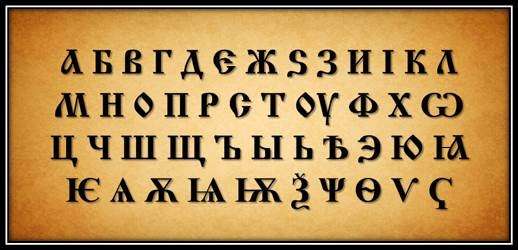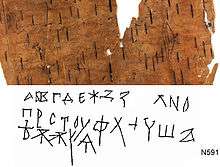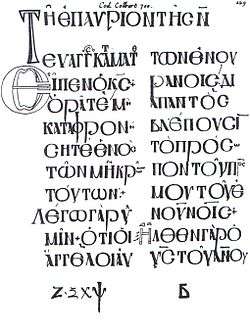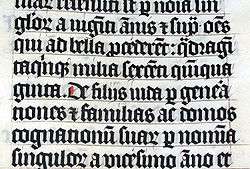Early Cyrillic alphabet
| Early Cyrillic alphabet | |
|---|---|
 | |
| Type | |
| Languages | Old Church Slavonic, Church Slavonic, old versions of many Slavic languages |
Time period | from circa 893 |
Parent systems |
Egyptian hieroglyphs [1]
|
Sister systems |
Latin alphabet Coptic alphabet Armenian |
| Direction | Varies |
| ISO 15924 |
Cyrs, 221 |
| |
The Early Cyrillic alphabet is a writing system that was developed during the late ninth century on the basis of the Greek alphabet[2][3][4] for the Orthodox Slavic population in Europe.[5] It was developed in the Preslav Literary School in the First Bulgarian Empire in order to write the Old Church Slavonic language.[6][7] The modern Cyrillic script is still used primarily for Slavic languages, and for Asian languages that were under Russian cultural influence during the 20th century.

History

The earliest form of manuscript Cyrillic, known as ustav, was based on Greek uncial script, augmented by ligatures and by letters from the Glagolitic alphabet for consonants not found in Greek.[8]
The Glagolitic alphabet was created by the monk Saint Cyril, possibly with the aid of his brother Saint Methodius, around 863.[8] Cyrillic, on the other hand, may have been a creation of Cyril's students (most notable of which was Clement of Ohrid) in the 890s at the Preslav Literary School under Bulgarian Tsar Simeon the Great as a more suitable script for church books, though retaining the original Bulgarian symbols in Glagolitic.[9] An alternative hypothesis proposes that it emerged in the border regions of Greek proselytization to the Slavs before it was codified and adapted by some systematizer among the Slavs; the oldest Cyrillic manuscripts look very similar to 9th and 10th century Greek uncial manuscripts,[8] and the majority of uncial Cyrillic letters were identical to their Greek uncial counterparts.[10] One possibility is that this systematization of Cyrillic was undertaken at the Council of Preslav in 893, when the Old Church Slavonic liturgy was adopted by the Bulgarian Empire.[10]
The Cyrillic alphabet was very well suited for the writing of Old Church Slavic, generally following a principle of "one letter for one significant sound", with some arbitrary or phonotactically-based exceptions.[8] Particularly, this principle is violated by certain vowel letters, which represent [j] plus the vowel if they are not preceded by a consonant.[8] It is also violated by a significant failure to distinguish between /ji/ and /jĭ/ orthographically.[8] There was no distinction of capital and lowercase letters, though manuscript letters were rendered larger for emphasis, or in various decorative initial and nameplate forms.[9] Letters served as numerals as well as phonetic signs; the values of the numerals were directly borrowed from their Greek-letter analogues.[8] Letters without Greek equivalents mostly had no numeral values, whereas one letter, koppa, had only a numeric value with no phonetic value.[8]
Since its creation, the Cyrillic script has adapted to changes in spoken language and developed regional variations to suit the features of national languages. It has been the subject of academic reforms and political decrees. Variations of the Cyrillic script are used to write languages throughout Eastern Europe and Asia.
The form of the Russian alphabet underwent a change when Tsar Peter the Great introduced the Civil Script (Russian: гражданскій шрифтъ, graždanskij šrift, or граждaнкa, graždanka, in contrast to the prevailing Church Typeface, Russian: церковнославя́нскій шрифтъ, cerkovnoslavjanskij šrift) in 1708. Some letters and breathing marks which were only used for historical reasons were dropped. Medieval letterforms used in typesetting were harmonized with Latin typesetting practices, exchanging medieval forms for Baroque ones, and skipping the western European Renaissance developments. The reform subsequently influenced Cyrillic orthographies for most other languages. Today, the early orthography and typesetting standards only remain in use in Church Slavonic.
A comprehensive repertoire of early Cyrillic characters is included in the Unicode since version 5.1 standard, which published on April 4, 2008. These characters and their distinctive letterforms are represented in specialized computer fonts for Slavistics.
Alphabet
| Image | Unicode | Name (Cyrillic) |
Name (translit.) |
Name (IPA) |
Trans. | IPA | Numeric value | Origin | Meaning | Notes |
|---|---|---|---|---|---|---|---|---|---|---|
| |
А а | азъ | azŭ | [azŭ] | a | [a] | 1 | Greek alpha Α | I | |
| |
Б б | боукꙑ | buky | [bukɯ] | b | [b] | Greek beta in Thera form |
letters | ||
| |
В в | вѣдѣ | vědě | [vædæ] | v | [v] | 2 | Greek beta Β | know | |
| |
Г г | глаголи | glagoli | [ɡlaɡoli] | g | [a][8] | 3 | Greek gamma Γ | speak | |
| |
Д д | добро | dobro | [dobro] | d | [d] | 4 | Greek delta Δ | good | When marked with a palatalization mark, this letter is pronounced [ɟ]; this only occurs rarely, and only in borrowings.[8] |
| |
Є є | єстъ | estŭ | [jɛstŭ] | e | [ɛ] | 5 | Greek epsilon Ε | is | Pronounced [jɛ] when not preceded by a consonant.[8] |
| |
Ж ж | живѣтє | živěte | [ʒivætɛ] | ž, zh | [ʒ] | Glagolitic zhivete Ⰶ | live | ||
| |
Ѕ ѕ / Ꙃ ꙃ | ꙃѣло | dzělo | [dzælo] | dz, ʒ,[8] ẑ | [dz] | 6 | Greek stigma Ϛ | very | The form ꙃ had the phonetic value [dz] and no numeral value, whereas the form ѕ was used only as a numeral and had no phonetic value.[8] In many manuscripts з is used instead, suggesting lenition had taken place.[8] |
| |
З з / Ꙁ ꙁ | зємл҄ꙗ | zemlja | [zɛmʎa] | z | [z] | 7 | Greek zeta Ζ | earth | The first form developed into the second. |
| |
И и | ижє | iže | [jiʒɛ] | i | [i] | 8 | Greek eta Η | which | Pronounced [ji] or [jĭ] when not preceded by a consonant and not the particle ‹i› ("and"); the orthography does not distinguish between [ji] and [jĭ].[8] Speculatively, this letter might have originally been intended to represent [i] and [ji].[8] |
| |
І і / Ї ї | и | i | [i] | i, ı, ì | [i] | 10 | Greek iota Ι | and | Pronounced [ji] or [jĭ] when not preceded by a consonant and not the particle ‹i› ("and"); the orthography does not distinguish between [ji] and [jĭ].[8] Speculatively, this letter might have originally been intended to represent [jĭ].[8] |
| |
К к | како | kako | [kako] | k | [k] | 20 | Greek kappa Κ | as | When marked with a palatalization mark, this letter is pronounced [c]; this only occurs rarely, and only in borrowings.[8] |
| |
Л л | людиѥ | ljudije | [ʎudijɛ] | l | [l]; sometimes [ʎ][8] | 30 | Greek lambda Λ | people | When marked with a palatalization mark or followed by a palatalizing vowel (ю, ѭ, or ꙗ, and sometimes ѣ), this letter is pronounced [ʎ]; some manuscripts do not mark palatalization, in which case it must be inferred from context.[8] |
| |
М м | мꙑслитє | myslite | [mɯslitɛ] | m | [m] | 40 | Greek mu Μ | think | |
| |
Н н | нашь | našĭ | [naʃĭ] | n | [n]; sometimes [ɲ][8] | 50 | Greek nu Ν | ours | When marked with a palatalization mark or followed by a palatalizing vowel (ю, ѭ, or ꙗ, and sometimes ѣ), this letter is pronounced [ɲ]; some manuscripts do not mark palatalization, in which case it must be inferred from context.[8] |
| |
О о | онъ | onŭ | [onŭ] | o | [o] | 70 | Greek omicron Ο | he/it | |
| |
П п | покои | pokoi | [pokojĭ] | p | [p] | 80 | Greek pi Π | peace/calm | |
| |
Р р | рьци | rĭci | [rĭtsi] | r | [ɲ]; sometimes [rʲ][8] | 100 | Greek rho Ρ | say | When marked with a palatalization mark or followed by a palatalizing vowel (ю or ѭ), this letter is pronounced [rʲ]; some manuscripts do not mark palatalization, in which case it must be inferred from context.[8] This palatalization was lost rather early in South Slavic speech.[8] |
| |
С с | слово | slovo | [slovo] | s | [s] | 200 | Greek lunate sigma Ϲ | word/speech | |
| |
Т т | тврьдо | tvrĭdo | [tvrĭdo] | t | [t] | 300 | Greek tau Τ | hard/surely | |
| |
Оу оу / Ꙋ ꙋ | оукъ | ukŭ | [ukŭ] | u | [u] | 400 | Greek omicron-upsilon ΟΥ / Ꙋ | learning | The first form developed into the second, a vertical ligature. A less common alternative form was a digraph with izhitsa: Оѵ оѵ. |
| |
Ф ф | фрьтъ | frĭtŭ | [frrĭtŭ] | f | [f] or possibly [p][8] | 500 | Greek phi Φ | This letter was not needed for Slavic but used to transcribe Greek Φ and Latin ph and f.[8] It was probably, but not certainly, pronounced as [f] rather than [p]; however, in some cases it has been found as a transcription of Greek π.[8] | |
| |
Х х | хѣръ | xěrŭ | [xærŭ] | kh, x,[8] h | [x] | 600 | Greek chi Χ | When marked with a palatalization mark, this letter is pronounced [ç]; this only occurs rarely, and only in borrowings.[8] | |
| |
Ѡ ѡ | отъ | otŭ | [otŭ] | ō, w, o, ô | [o] | 800 | Greek omega ω | from | This letter was rarely used, mostly appearing in the interjection "oh", in the preposition ‹otŭ›, in Greek transcription, and as a decorative capital.[8] |
| |
Ц ц | ци | ci | [tsi] | c | [ts] | 900 | Glagolitic tsi Ⱌ | ||
| |
Ч ч | чрьвь | črĭvĭ | [tʃrĭvĭ] | č, ch | [tʃ] | 90 | Glagolitic cherv Ⱍ | worm | This letter replaced koppa as the numeral for 90 after about 1300.[8] |
| |
Ш ш | ша | ša | [ʃa] | š, sh | [ʃ] | Glagolitic sha Ⱎ | |||
| |
Щ щ | ща | šta | [ʃta] | št, sht | [ʃt] | Glagolitic shta Ⱋ | This letter varied in pronunciation from region to region; it may have originally represented the reflexes of [tʲ].[8] It was sometimes replaced by the digraph шт.[8] Pronounced [ʃtʃ] in Old East Slavic. Later analyzed as a Ш-Т ligature by folk etymology, but neither the Cyrillic nor the Glagolitic glyph originated as such a ligature.[8] | ||
| |
Ъ ъ | ѥръ | jerŭ | [jɛrŭ] | ŭ, ъ[8] | [m] or [ʊ][8] | Glagolitic yer Ⱏ[10] | After č, š, ž, c, dz, št, and žd, this letter was pronounced identically to ь instead of its normal pronunciation.[8] | ||
| |
Ꙑ ꙑ / Ъи ъи[8] | ѥрꙑ | jery | [jɛrɯ] | y | [o] or [ɯji] or [ɯjĭ][8] | Ъ + І or Ъ + И ligature. | Ꙑ was the more common form; rarely, a third form, ы, appears.[8] | ||
| |
Ь ь | ѥрь | jerĭ | [jɛrĭ] | ĭ, ь[8] | [ĭ] or [j][8] | Glagolitic yerj Ⱐ[10] | |||
| |
Ѣ ѣ | ѣть | ětĭ | [jætĭ] | ě | [æ][8] | Glagolitic yat Ⱑ[10] | In western South Slavic dialects of Old Church Slavonic, this letter had a more closed pronunciation, perhaps [ɛ] or [e].[8] This letter was only written after a consonant; in all other positions, ꙗ was used instead.[8] | ||
| |
Ꙗ ꙗ | ꙗ | ja | [ja] | ja | [ja] | І-А ligature | This letter was probably not present in the original Cyrillic alphabet.[10] | ||
| |
Ѥ ѥ | ѥ | je | [jɛ] | je | [jɛ] | І-Є ligature | This letter was probably not present in the original Cyrillic alphabet.[10] | ||
| |
Ю ю | ю | ju | [ju] | ju | [ju] | І-ОУ ligature, dropping У | There was no [jo] sound in early Slavic, so І-ОУ did not need to be distinguished from І-О. After č, š, ž, c, dz, št, and žd, this letter was pronounced [u], without iotation. | ||
| |
Ѫ ѫ | ѫсъ | ǫsŭ | [ɔ̃sŭ] | ǫ, õ | [ɔ̃] | Glagolitic ons Ⱘ | Called юсъ большой (big yus) in Russian. | ||
| |
Ѭ ѭ | ѭсъ | jǫsŭ | [jɔ̃sŭ] | jǫ, jõ | [jɔ̃] | І-Ѫ ligature | After č, š, ž, c, dz, št, and žd, this letter was pronounced [ɔ̃], without iotation. Called юсъ большой йотированный (iotated big yus) in Russian. | ||
| |
Ѧ ѧ | ѧсъ | ęsŭ | [jɛ̃sŭ] | ę, ẽ | [ɛ̃] | 900 | Glagolitic ens Ⱔ | Pronounced [jɛ̃] when not preceded by a consonant.[8] Called юсъ малый (little yus) in Russian. | |
| |
Ѩ ѩ | ѩсъ | jęsŭ | [jɛ̃sŭ] | ję, jẽ | [jɛ̃] | І-Ѧ ligature | This letter does not exist in the oldest (South Slavic) Cyrillic manuscripts, but only in East Slavic ones.[8] It was probably not present in the original Cyrillic alphabet.[10] Called юсъ малый йотированный (iotated little yus) in Russian. | ||
| |
Ѯ ѯ | ѯи | ksi | [ksi] | ks | [ks] | 60 | Greek xi Ξ | These two letters were not needed for Slavic but were used to transcribe Greek and as numerals. | |
| |
Ѱ ѱ | ѱи | psi | [psi] | ps | [ps] | 700 | Greek psi Ψ | ||
| |
Ѳ ѳ | фита | fita | [fita] | θ, th, T, F | [t], or possibly [θ] | 9 | Greek theta Θ | This letter was not needed for Slavic but was used to transcribe Greek and as a numeral. It seems to have been generally pronounced [t], as the oldest texts sometimes replace instances of it with т.[8] Normal Old Church Slavonic pronunciation probably did not have a phone [θ].[8] | |
| |
Ѵ ѵ | ижица | ižica | [jiʒitsa] | ü, v, ỳ | [i], [y], [v] | 400 | Greek upsilon Υ | small yoke | This letter was used to transcribe Greek upsilon and as a numeral. It also formed part of the digraph оѵ. |
| |
Ҁ ҁ | копа | kopa | [kopa] | q | no sound value | 90 | Greek koppa Ϙ | This letter had no phonetic value, and was only used as a numeral. After about 1300, it was replaced as a numeral by črĭvĭ.[8] |
| South Slavic languages and dialects | ||||||
|---|---|---|---|---|---|---|
|
Western South Slavic
|
||||||
|
Transitional dialects
|
||||||
|
Alphabets |
||||||
In addition to the basic letters, there were a number of scribal variations, combining ligatures, and regionalisms used, all of which varied over time.
Numerals, diacritics and punctuation
Each letter had a numeric value also, inherited from the corresponding Greek letter. A titlo over a sequence of letters indicated their use as a number; usually this was accompanied by a dot on either side of the letter.[8] In numerals, the ones place was to the left of the tens place, the reverse of the order used in modern Arabic numerals.[8] Thousands are formed using a special symbol, ҂ (U+0482), which was attached to the lower left corner of the numeral.[8] Many fonts display this symbol incorrectly as being in line with the letters instead of subscripted below and to the left of them.
Titlos were also used to form abbreviations, especially of nomina sacra; this was done by writing the first and last letter of the abbreviated word along with the word's grammatical endings, then placing a titlo above it.[8] Later manuscripts made increasing use of a different style of abbreviation, in which some of the left-out letters were superscripted above the abbreviation and covered with a pokrytie diacritic.[8]
Several diacritics, adopted from Polytonic Greek orthography, were also used, but were seemingly redundant[8] (these may not appear correctly in all web browsers; they are supposed to be directly above the letter, not off to its upper right):
- ӓ trema, diaeresis (U+0308)
- а̀ varia (grave accent), indicating stress on the last syllable (U+0300)
- а́ oksia (acute accent), indicating a stressed syllable (Unicode U+0301)
- а҃ titlo, indicating abbreviations, or letters used as numerals (U+0483)
- а҄ kamora (circumflex accent), indicating palatalization (U+0484); in later Church Slavonic, it disambiguates plurals from homophonous singulars.
- а҅ dasia or dasy pneuma, rough breathing mark (U+0485)
- а҆ psili, zvatel'tse, or psilon pneuma, soft breathing mark (U+0486). Signals a word-initial vowel, at least in later Church Slavonic.
- а҆̀ Combined zvatel'tse and varia is called apostrof.
- а҆́ Combined zvatel'tse and oksia is called iso.
Punctuation systems in early Cyrillic manuscripts were primitive: there was no space between words and no upper and lower case, and punctuation marks were used inconsistently in all manuscripts.[8]
- · ano teleia (U+0387), a middle dot used to separate phrases, words, or parts of words[8]
- . Full stop, used in the same way[8]
- ։ Armenian full stop (U+0589), resembling a colon, used in the same way[8]
- ჻ Georgian paragraph separator (U+10FB), used to mark off larger divisions
- ⁖ triangular colon (U+2056, added in Unicode 4.1), used to mark off larger divisions
- ⁘ diamond colon (U+2058, added in Unicode 4.1), used to mark off larger divisions
- ⁙ quintuple colon (U+2059, added in Unicode 4.1), used to mark off larger divisions
- ; Greek question mark (U+037E), similar to a semicolon
Some of these marks are also used in Glagolitic script.
Used only in modern texts
- , comma (U+002C)
- . full stop (U+002E)
- ! exclamation mark (U+0021)
Gallery
Medieval Greek Uncial manuscripts from which early Cyrillic letter forms take their shapes
Early Cyrillic manuscripts
- Pictures of Old Church Slavonic weekly gospels (aprakos)






 Andronikov Gospels
Andronikov Gospels
See also
![]() Media related to early Cyrillic alphabet at Wikimedia Commons
Media related to early Cyrillic alphabet at Wikimedia Commons
- Relationship of Cyrillic and Glagolitic scripts
- Bosnian Cyrillic
- Romanian Cyrillic alphabet
- Reforms of Russian orthography
References
- ↑ Himelfarb, Elizabeth J. "First Alphabet Found in Egypt", Archaeology 53, Issue 1 (Jan./Feb. 2000): 21.
- ↑ Mauricio Borrero, "Russia", p. 123
- ↑ World Cultures Through Art Activities, Dindy Robinson, p. 115
- ↑ Handbook of Scripts and Alphabets, George L. Campbell, p. 42
- ↑ "Cyrillic alphabet". Encyclopædia Britannica. Encyclopædia Britannica Online. Encyclopædia Britannica Inc., 2012. Web. 16 May. 2012
- ↑ The Orthodox Church in the Byzantine Empire, Oxford History of the Christian Church, J. M. Hussey, Andrew Louth, Oxford University Press, 2010, ISBN 0191614882, p. 100.
- ↑ Southeastern Europe in the Middle Ages, 500-1250, Cambridge Medieval Textbooks, Florin Curta, Cambridge University Press, 2006, ISBN 0521815398, pp. 221-222.
- 1 2 3 4 5 6 7 8 9 10 11 12 13 14 15 16 17 18 19 20 21 22 23 24 25 26 27 28 29 30 31 32 33 34 35 36 37 38 39 40 41 42 43 44 45 46 47 48 49 50 51 52 53 54 55 56 57 58 59 60 61 62 Lunt, Horace G. Old Church Slavonic Grammar, Seventh Edition, 2001.
- 1 2 Cubberley 1994
- 1 2 3 4 5 6 7 8 Auty, R. Handbook of Old Church Slavonic, Part II: Texts and Glossary. 1977.
Sources
- Berdnikov, Alexander and Olga Lapko, ""Old Slavonic and Church Slavonic in TEX and Unicode"" (PDF)., EuroTEX ’99 Proceedings, September 1999
- Birnbaum, David J., "Unicode for Slavic Medievalists" (PDF)., September 28, 2002
- Cubberley, Paul (1996) "The Slavic Alphabets". In Daniels and Bright, below.
- Daniels, Peter T., and William Bright, eds. (1996). The World's Writing Systems. Oxford University Press. ISBN 0-19-507993-0.
- Everson, Michael and Ralph Cleminson, ""Final proposal for encoding the Glagolitic script in the UCS", Expert Contribution to the ISO N2610R" (PDF)., September 4, 2003
- Franklin, Simon. 2002. Writing, Society and Culture in Early Rus, c. 950–1300. Cambridge University Press. ISBN 0-511-03025-8.
- Iliev, I. Short History of the Cyrillic Alphabet. Plovdiv. 2012/Иван Г. Илиев. Кратка история на кирилската азбука. Пловдив. 2012. Short History of the Cyrillic Alphabet
- Lev, V., "The history of the Ukrainian script (paleography)", in Ukraine: a concise encyclopædia, volume 1. University of Toronto Press, 1963, 1970, 1982. ISBN 0-8020-3105-6
- Simovyc, V., and J. B. Rudnyckyj, "The history of Ukrainian orthography", in Ukraine: a concise encyclopædia, volume 1 (op cit).
- Zamora, J., Help me learn Church Slavonic
- Azbuka, Church Slavonic calligraphy and typography.
- Obshtezhitie.net, Cyrillic and Glagolitic manuscripts and early printed books.
External links
- Old Cyrillic [Стара Славянска Език] text entry application
- Slavonic Computing Initiative
- churchslavonic – Typesetting documents in Church Slavonic language using Unicode
- fonts-churchslavonic – Fonts for typesetting in Church Slavonic language
- Church Slavonic Typography in Unicode (Unicode Technical Note no. 41), 2015-11-04, accessed 2016-02-23.


%2C_f.115r.jpg)
